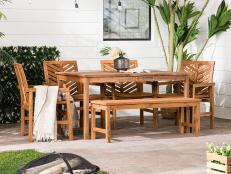How to Design a Perfect Path

A perfect path can invite visitors to move safely and quickly to the front door or tease the eye by narrowing then disappearing around a bend. In each instance, a path leading to a garden space not only accomplishes its purpose but serves as a backbone to the plantings around it.
Cut flagstone is the most formal paving material, followed by brick, irregular flagstone, exposed aggregate and concrete. But details make a big difference, dramatically altering the appearance and feel of a path.
Here are examples of how construction details can influence the finished look:
- Flagstone with mortared joints is more formal than the same stone laid on sand. The latter invites a gardener to tuck tiny plants, such as creeping thyme, into cracks. Moss will appear on its own if the pavement is shaded.
- A brick entrance walk done in an old-fashioned basket-weave pattern sets a more relaxed tone than a straightforward running-bond pattern. The former may be more appropriate for a farmhouse or Victorian-style home, while the latter is better suited to contemporary architecture. Find examples of paving partners in landscape design texts that emphasize construction techniques or hardscape. Notice how significantly patterns differ and what effect each one has on the outcome.
- Concrete stamped by using a special decorative pattern (there are several styles to choose from) is more elegant than plain concrete. Tinting the concrete also allows a gardener to match, or contrast, that surface with features around it.
- Brick or flagstone edging makes a plain exposed aggregate walkway more beautiful and formal. Edging also can help indicate elevation changes, such as where steps begin, thus making a walkway safer.
- Old, recycled brick often blends better with natural, more relaxed settings than new paving bricks. Pavers usually are bright in color and stand out from their surroundings.
Old bricks can be slightly irregular in size, and some may have chipped edges. Fill cracks with tiny plants or moss for an even older look. When selecting old brick, search for the hardest ones you can find. Soft brick, sometimes called house brick, is fired at a lower temperature; it won't wear as well as paving brick when used as a path.
Informal paths can be paved with stepping stones, gravel, crushed slag, grass, bark chips, pine needles or hard-packed earth.
The width of a walkway is an important feature. People move more quickly and with greater ease on wide paths than they do on narrow ones. A 5-foot wide walkway allows visitors to comfortably proceed in double file.
Narrow paths require travelers to slow down, a pace appropriate for strolling. People glance down more frequently along narrow garden paths, especially if the footing is uneven. As a gardener, seize the opportunity to grow small plants and combine them in interesting ways.
A path that disappears around a corner encourages visitors to explore. The bed that screens the porch from view is the perfect spot for a small tree or specimen plant.
The shape of a path — curving or straight — is determined by the degree of formality you want. Resist the urge to curve a walk if it feels forced to do it. Curve the beds around it instead for that more relaxed feeling.
A straight walk through a main garden room offers the chance to highlight a special view. At the end, switch to a narrow curving walk to quickly change the mood and indicate the beginning of a new and separate garden space.













































